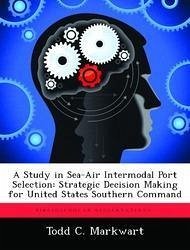World events and changes in the expeditionary force structure and strategy of the U.S. military have altered the traditional approach to operational employment and readiness. Greater flexibility and speed are required to carry out operations; aided by intermodal transport options to quickly and efficiently move supplies in support of geographic combatant commanders' requirements. The United States Transportation Command is responsible for making decisions on the most efficient mix of sea and airport operations to support U.S. Government and Department of Defense movement requirements worldwide, and the selection of the best port pairs is critical in executing that mission. U.S. TRANSCOM has used a decision model which evaluates ten sea and airport factors to prioritize port pairs, but recent operations have refocused the need for evolving logistical planning. This research uses a "value focused" methodology to identify factors and data sources to broaden the scope of the existing model to help U.S. TRANSCOM remain flexible in supporting worldwide CCDRs, including U.S. SOUTHCOM.
Hinweis: Dieser Artikel kann nur an eine deutsche Lieferadresse ausgeliefert werden.
Hinweis: Dieser Artikel kann nur an eine deutsche Lieferadresse ausgeliefert werden.








